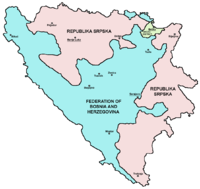Though considered a political backwater of the federation for much of the 1950s and 1960s, the 1970s saw the ascension of a strong Bosnian political elite. While working within the communist system, politicians such as Džemal Bijedić, Branko Mikulić and Hamdija Pozderac reinforced and protected the sovereignty of Bosnia and Herzegovina [10] Their efforts proved key during the turbulent period following Tito's death in 1980, and are today considered some of the early steps towards Bosnian independence. However, the republic could not escape the increasingly nationalistic climate of the time unscathed. With the fall of communism and the start of the breakup of Yugoslavia, the old communist doctrine of tolerance began to lose its potency, creating an opportunity for nationalist elements in the society to spread their influence.
Bosnian War (1992-1995)

Coat of arms of The Republic of Bosnia and Herzegovina 1992–1998
While the first casualty of the war is debated, significant Serbian offensives began in March 1992 in Eastern and Northern Bosnia. Following a tense period of escalating tensions the opening shots in the incipient Bosnian conflict were fired when Serb paramilitary forces attacked Bosniak villages around Čapljina on 7 March 1992 and around Bosanski Brod and Goražde on 15 March. These minor attacks were followed by much more serious Serb artillery attacks on Neum on 19 March and on Bosanski Brod on 24 March. The killing of a Bosniak civilian woman on 5 April 1992 by a sniper, while she was demonstrating in Sarajevo against the raising of barricades by Bosnian Serbs, is widely regarded as marking the start of warfare between the three major communities. Open warfare began in Sarajevo on 6 April. International recognition of Bosnia and Herzegovina meant that the Yugoslav People's Army (JNA) officially withdrew from the republic's territory, although their Bosnian Serb members merely joined the Army of Republika Srpska. Armed and equipped from JNA stockpiles in Bosnia, supported by volunteers, Republika Srpska's offensives in 1992 managed to place much of the country under its control.By 1993, when an armed conflict erupted between the Sarajevo government and the Croat statelet of Herzeg-Bosnia, about 70% of the country was controlled by the Serbs.
In March 1994, the signing of the Washington accords between the Bosniak and ethnic-Croatian leaders led to the creation of a joint Bosniak-Croat Federation of Bosnia and Herzegovina. This, along with international outrage at Serb war crimes and atrocities (most notably the Srebrenica massacre of as many as 8,000 Bosniak males in July 1995[) helped turn the tide of war. The signing of the Dayton Agreement in Paris by the presidents of Bosnia and Herzegovina (Alija Izetbegović), Croatia (Franjo Tuđman), and Yugoslavia (Slobodan Milošević) brought a halt to the fighting, roughly establishing the basic structure of the present-day state. The three years of war and bloodshed had left between 90,000 and 110,000 people killed and more than 2 million displaced.
Independent Bosnia and Herzegovina

Coat of arms of Bosnia and Herzegovina
See also: Politics of Bosnia and Herzegovina
Since its 1992 independence and the 1995 Constitutional framework of the Dayton Agreement, Bosnia and Herzegovina has followed a path of state-building, while remaining under final international supervision through the figure of the High Representative for Bosnia and Herzegovina. Bosnia and Herzegovina is a confederation of two Entities - the Federation of Bosnia and Herzegovina and the Republika Srpska, as well as the district of Brčko. Each of the Entities has its own constitution and extensive legislative powers.Bosnia and Herzegovina is a potential candidate country for accession into the EU; an EU-BiH Stabilization and Association Agreement has been signed in 2008. Its accession to NATO is in the phase of negotiation, and a Membership Action Plan has been signed in April 2010.


